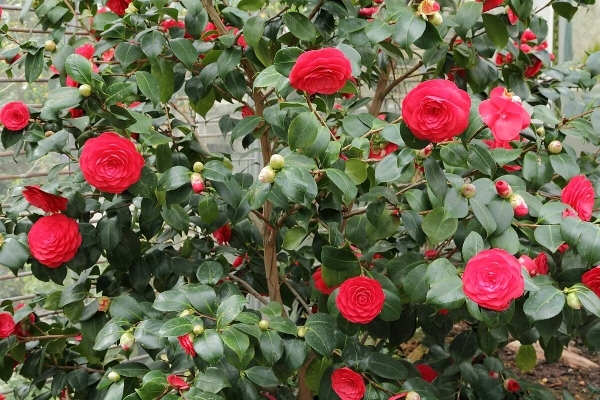
Camellia
Botanical Name
:
Camellia spp.
Plant Type
:
Broadleaf evergreen shrub
Seasons
:
Plant in spring or fall; Blooms from late winter to early spring
Sun Level
:
Partial shade; prefers dappled sunlight or morning sun with afternoon shade
Ideal Soil Temperature for Planting
:
55–70°F (13–21°C)
Soil Type
:
Acidic, well-drained, organic-rich soil
Hardiness Zones
:
6–9 (USDA)
Germination
:
Seeds germinate in 1–2 months; cuttings are preferred for propagation
P.H. Level
:
Acidic (5.0–6.8)
Water/Irrigation
:
Camellias need 1 inch of water per week during flowering and every 10 days to 2 weeks during extended dry periods; drought-tolerant
Fertilization
:
Use an acid-forming fertilizer (e.g., for azaleas or rhododendrons) with an NPK ratio around 4-8-8 in early spring and midsummer
Habit
:
Dense, rounded growth habit
Propagation
:
Seeds, cuttings, layering, and grafting
Final Plant Height
:
6–12 ft; but some can be up to 20 ft
Spread
:
5–10 ft
Flowers
:
White, pink, red, yellow, or lavender; rose-like blooms
Attracts
:
Bees, songbirds, and other pollinators
Uses
:
Foundation plant, hedge, woodland garden, container gardening; can have therapeutic uses
Companions
:
Azaleas, rhododendrons, ferns, hostas, scillas, snowdrops, Japanese maples, mahonia, sweet box, corylopsis, and daffodils
Pruning
:
Prune after flowering; remove dead or weak branches to maintain shape
Toxicity
:
Generally non-toxic, but seeds contain caffeine and can cause discomfort if ingested in large quantities
Pests
:
Scale insects, aphids, and spider mites
Diseases
:
Camellia petal blight, root rot, leaf gall, and sooty mold
Fun Fact
:
Camellias are known as the “Queen of Winter Flowers” due to their stunning blooms during the colder months
Botanical Name
:
Camellia spp.
Plant Type
:
Broadleaf evergreen shrub
Seasons
:
Plant in spring or fall; Blooms from late winter to early spring
Sun Level
:
Partial shade; prefers dappled sunlight or morning sun with afternoon shade
Ideal Soil Temperature for Planting
:
55–70°F (13–21°C)
Soil Type
:
Acidic, well-drained, organic-rich soil
Hardiness Zones
:
6–9 (USDA)
Germination
:
Seeds germinate in 1–2 months; cuttings are preferred for propagation
P.H. Level
:
Acidic (5.0–6.8)
Water/Irrigation
:
Camellias need 1 inch of water per week during flowering and every 10 days to 2 weeks during extended dry periods; drought-tolerant
Fertilization
:
Use an acid-forming fertilizer (e.g., for azaleas or rhododendrons) with an NPK ratio around 4-8-8 in early spring and midsummer
Habit
:
Dense, rounded growth habit
Propagation
:
Seeds, cuttings, layering, and grafting
Final Plant Height
:
6–12 ft; but some can be up to 20 ft
Spread
:
5–10 ft
Flowers
:
White, pink, red, yellow, or lavender; rose-like blooms
Attracts
:
Bees, songbirds, and other pollinators
Uses
:
Foundation plant, hedge, woodland garden, container gardening; can have therapeutic uses
Companions
:
Azaleas, rhododendrons, ferns, hostas, scillas, snowdrops, Japanese maples, mahonia, sweet box, corylopsis, and daffodils
Pruning
:
Prune after flowering; remove dead or weak branches to maintain shape
Toxicity
:
Generally non-toxic, but seeds contain caffeine and can cause discomfort if ingested in large quantities
Pests
:
Scale insects, aphids, and spider mites
Diseases
:
Camellia petal blight, root rot, leaf gall, and sooty mold
Fun Fact
:
Camellias are known as the “Queen of Winter Flowers” due to their stunning blooms during the colder months
Written by Nondiah Khalayi – https://www.linkedin.com/in/nondiah-khalayi/

